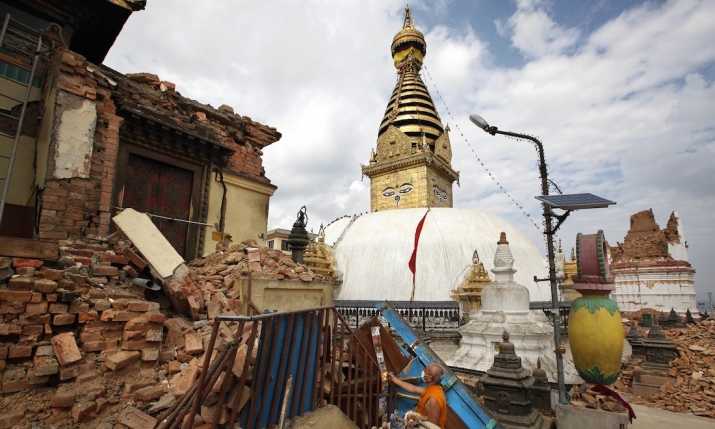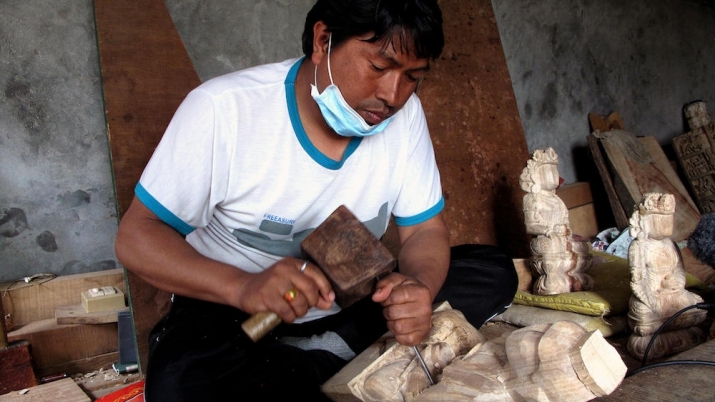NEWS
Nepal Moves to Rebuild Earthquake-damaged Heritage Sites
 A Buddhist monk salvages religious items from a monastery near the Swayambhunath Stupa. From theguardian.com
A Buddhist monk salvages religious items from a monastery near the Swayambhunath Stupa. From theguardian.comMobilizing to rebuild and restore hundreds of historic Buddhist and Hindu monuments that were damaged by April’s 7.8-magnitude earthquake, Nepal’s government has set a reconstruction timeline of seven years and a budget of US$200 million to cover all of Nepal’s 16 districts.
The massive earthquakes that hit on 25 April and 12 May killed more than 8,500 people, destroying thousands of houses and displacing millions. The devastation also extended to hundreds of ancient buildings, monasteries, and temples. According to a preliminary assessment by Nepal’s Department of Archaeology, more than 400 historic monuments in the Kathmandu Valley were damaged, of which 35—in six of the area’s seven UNESCO World Heritage sites—have collapsed entirely. At a national level, government estimates put the number of destroyed and damaged sites of religious and cultural significance at 2,900.
The government restoration fund will be bolstered by donations from Australia, China, India, Hong Kong, and Sri Lanka, which have pledged to support the reconstruction of specific sites, including some in Kathmandu’s Durbar Square, the Changu Narayan Temple in Bhaktapur, the Swayambhunath Stupa, and other monuments in Bungamati, Khokana, and upper mountainous regions, such as Manang and Mustang.
“So many temples have collapsed,” said 74-year-old Kathmandu resident Lok Bahadur Shakya, who played in the palatial, centuries-old Patan Durbar Square as a child. “These aren’t just monuments for us—it’s where our gods live. They symbolize our faith.” (South China Morning Post)
 Master carvers play a key role in restoring Nepal's damaged temples and monuments. Photo from npr.org
Master carvers play a key role in restoring Nepal's damaged temples and monuments. Photo from npr.orgThe cultural history of the Kathmandu Valley is the historical result of a confluence of Asian religions, cultures, and trade routes that led to a mix of Indian and Tibetan architectural styles with Hindu and Buddhist iconography. UNESCO lists seven World Heritage monuments in the area—Kathmandu Durbar Square, Patan Durbar Square, Bhaktapur Durbar Square, the Changu Narayan Hindu temple, Swayambhunath Buddhist stupa, the Bauddhanath Buddhist stupa complex, and Pashupati Nath Hindu temple.
In addition to the stupa, the Swayambhunath complex, dating to the 5th century, includes a variety of shrines and temples, a Tibetan monastery, a museum, and a library. The Bauddhanath Stupa’s massive mandala, meanwhile, makes the monument one of the largest spherical stupas in Nepal. Refugees from Tibet have constructed more than 50 monasteries around the stupa. Both sites suffered significant damage from this year’s quakes.
According to conservation architect Rohit Ranjitkar, director of the Kathmandu Valley Preservation Trust (KVPT), one of the biggest challenges of the restoration process is the lack of local artisans, including sculptors and woodcarvers. Such artists are usually underappreciated and underpaid, discouraging the younger generation from undertaking what is now viewed as an unglamorous vocation.
Meanwhile, historian Dr. Dina Bangdel, who specializes in South Asian and Himalayan art, observed that Nepal’s Ancient Monument Preservation Act, passed in 1956, is in urgent need of revision. “We don’t have structured guidelines for the preservation and renovation of these monuments in light of new technologies and engineering methods,” she said. “The renovations [we do] are not up to international standards and there is no quality control. We were not ready for this earthquake.” (South China Morning Post)
See more
Restoring Nepal's earthquake-hit monuments is a ‘race against time’ (South China Morning Post)
Nepal begins to assess its cultural losses after earthquake (The Guardian)














